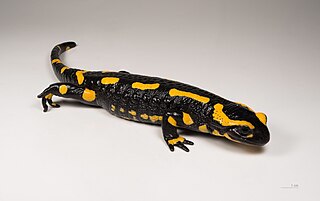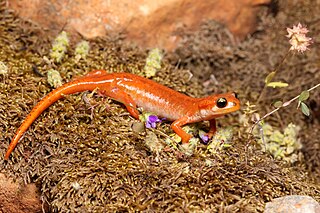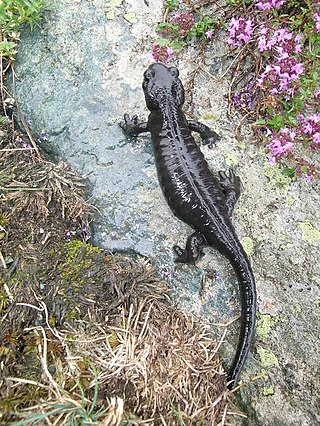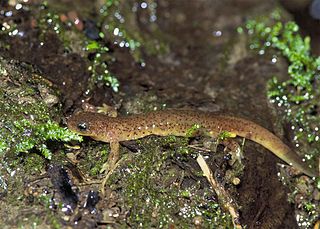
Salamanders are a group of amphibians typically characterized by their lizard-like appearance, with slender bodies, blunt snouts, short limbs projecting at right angles to the body, and the presence of a tail in both larvae and adults. All ten extant salamander families are grouped together under the order Urodela from the group Caudata. Salamander diversity is highest in eastern North America, especially in the Appalachian Mountains; most species are found in the Holarctic realm, with some species present in the Neotropical realm.

Salamandridae is a family of salamanders consisting of true salamanders and newts. Salamandrids are distinguished from other salamanders by the lack of rib or costal grooves along the sides of their bodies and by their rough skin. Their skin is very granular because of the number of poison glands. They also lack nasolabial grooves. Most species of Salamandridae have moveable eyelids but lack lacrimal glands.

The fire salamander is a common species of salamander found in Europe.

The alpine salamander is a black salamander that can be found in the French Alps, and through the mountainous range in Europe. It is a member of the genus Salamandra. Their species name, atra, may be derived from the Latin ater, meaning dull black. The salamanders' coloration has evolved over time, as some species are completely monochrome black and others have yellow spotting and marks. Their life expectancy is at least 10 years. There are four subspecies of the alpine salamander, with varied distribution and physical coloration. Unlike other salamanders, whose larvae are developed in water, the alpine salamander and its subspecies are a fully terrestrial species in life and gestation. They give birth to live young.
The salamander is an amphibian of the order Urodela which, as with many real creatures, often has been ascribed fantastic and sometimes occult qualities by pre-modern authors not possessed by the real organism. The legendary salamander is often depicted as a typical salamander in shape with a lizard-like form, but is usually ascribed an affinity with fire, sometimes specifically elemental fire.

The Corsican brook salamander or Corsican mountain newt is a species of salamander in the family Salamandridae. It is endemic to Corsica, an island in the Mediterranean Sea.
Lyciasalamandra flavimembris, the Marmaris Lycian salamander or Marmaris salamander, is a species of salamander in the family Salamandridae. It is endemic to Turkey and is found along the southwestern Anatolian coast between Marmaris and Ula. It was first described as subspecies of Mertensiella luschani, now Lyciasalamandra luschani.

Luschan's salamander or Lycian salamander is a species of salamander in the family Salamandridae. It is found in the southwestern Anatolia in Turkey and adjacent Greece, in the island of Kastellorizo and its satellites.

The Corsican fire salamander is a species of salamander in the family Salamandridae found only on the island of Corsica as an endemic species. In former times, this species was known as a subspecies of the widespread but continental-distributed fire salamander, which may appear quite similar.

The Near Eastern fire salamander, in Arabic arouss al-ayn, is a species of salamander in the family Salamandridae found in Iran, Iraq, Turkey, Syria, Lebanon, and Israel. Its natural habitats are subtropical dry shrubland and forests, often near rivers and freshwater springs. It is threatened by habitat loss.

Lanza's alpine salamander or the large alpine salamander is a species of salamander in the family Salamandridae, found in France and Italy. Its natural habitats are forests, grasslands, and pasturelands, all of which are temperate. It is threatened by habitat loss and potentially in the future by the fungal disease Batrachochytrium salamandrivorans.
Bolitoglossa borburata is a species of salamander in the family Plethodontidae. It is endemic to Venezuela. Its natural habitat is subtropical or tropical moist montane forests. It is also known as the Carabobo mushroomtongue.
Bolitoglossa orestes, commonly known as the Culata mushroomtongue salamander, is a species of salamander in the family Plethodontidae. It is endemic to the Mérida state of Venezuela.
Isthmura naucampatepetl, commonly known as the Cofre de Perote salamander, is a species of salamanders in the family Plethodontidae. It is endemic to the Sierra Madre Oriental in central Veracruz, Mexico, where it is known from between Cofre de Perote and Cerro Volcancillo, a satellite peak of Cofre de Perote.

The Olympic torrent salamander is a species of salamander in the family Rhyacotritonidae. This is a small salamander that lives in clear, cold, mountain streams. It is medium to dark brown and may have a few small light spots on the sides and small dark spots on the tail; it is bright yellow on the belly, usually with some dark spots. Torrent salamanders typically have short snouts and relatively large eyes. As in other torrent salamanders, adult males have square-edged lobes behind the cloaca. These salamanders live at the edges of clear, cold, mountain streams; they can be abundant under gravel at stream edges and in the spray zones of waterfalls. During rainy seasons, they are occasionally found under objects on land away from streams.
The reticulated flatwoods salamander is a species of mole salamander, an amphibian in the family Ambystomatidae. The species is native to a small portion of the southeastern coastal plain of the United States in the western panhandle of Florida and extreme southwestern Georgia. The species once occurred in portions of southern Alabama but is now considered extirpated there. Its ecology and life history are nearly identical to its sister species, the frosted flatwoods salamander. A. bishopi inhabits seasonally wet pine flatwoods and pine savannas west of the Apalachicola River-Flint River system. The fire ecology of longleaf pine savannas is well-known, but there is less information on natural fire frequencies of wetland habitats in this region. Like the frosted flatwoods salamander, the reticulated flatwoods salamander breeds in ephemeral wetlands with extensive emergent vegetation, probably maintained by summer fires. Wetlands overgrown with woody shrubs are less likely to support breeding populations.

Batrachochytrium salamandrivorans (Bsal) is a pathogenic chytrid fungus that infects amphibian species. Although salamanders and newts seem to be the most susceptible, some anuran species are also affected. Bsal has emerged recently and poses a major threat to species in Europe and North America.












